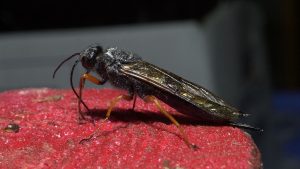#147: Cyathus striatus
This is one of the most common bird’s nest fungi and is among the easiest to identify. Cyathus striatus has a shaggy outer surface and a smooth but vertically lined inner surface, readily distinguishing it from the other bird’s nest fungi. Although frequently found in places like mulch beds, this mushroom’s common name – the “Fluted Bird’s Nest” – is not widely used. More often, people simply call this mushroom by its scientific name.
C. striatus is fairly large for a bird’s nest fungus, growing 0.7-1cm tall and 0.6-0.8cm wide. These mushrooms are vase-shaped and tend to have a wider brim than other bird’s nest fungi. On the outside, C. striatus is notable for its hairy to shaggy texture. The exterior is variable in color and can range from grayish to tan to dark brown. Young mushrooms have a membrane (called an ‘epiphragm’) over the top that is shaggy like the outer surface when very young but becomes white and smooth as the mushroom approaches maturity. When mature, this membrane breaks down to reveal the interior of the ‘nest.’
The sides of the mushroom’s interior are smooth, shiny, and characterized by radial striations or grooves. Once the eggs have been ejected, an irregular, unlined hollow is visible at the base of the nest. As with other mushrooms, the nest is more colorful and regular when fresh. As the mushrooms dry out, they become darker, more wrinkly, and more tube-shaped than cup-shaped. Dried C. striatus mushrooms are also less pliable than fresh ones, although even fresh mushrooms have rather tough flesh.
At the bottom of the nest, there are a pile of several spore-containing ‘eggs’ (formally called ‘peridioles’). Each egg is ovoid to nearly triangular, flattened, smooth, and usually no more than 2mm across. The eggs are generally gray in color but can range from light gray to dark gray. Another diagnostic feature that can help in the identification of C. striatus is that each egg is attached to the side of the nest by a thin cord called a ‘funiculus.’ Not all bird’s nest fungi have this feature, which can help separate out C. striatus. However, this is usually unnecessary because the funiculus is rather difficult to see and C. striatus can be easily differentiated by other factors.
C. striatus can be found decomposing wood and other forest debris in forests across North America and Europe. It often grows in large clusters, which helps you spot this otherwise well-camouflaged mushroom. MushroomExpert.com states that C. striatus is only occasionally found on woodchips, but in my experience it is one of the most common fungi found in mulch. This could point to some regional variations, since other websites do note that it grows on woodchips. C. striatus is a summer and fall mushroom, but may appear over winter in warmer climates.
There are many other mushrooms that look like bird’s nests (eggs inside a cup-shaped structure), but none of them have both a shaggy exterior and a striate interior.
As with other bird’s nest fungi, the odd shape of C. striatus allows it to disperse its spores using the power of falling raindrops. When a raindrop falls into the nest, the splash it creates as it hits the bottom dislodges one of the eggs and launches that egg into the air. This unique method of spore dispersal is called a ‘splash cup.’ In addition to this basic mechanism, C. striatus employs a funiculus. The funiculus is attached to an egg on one end and the side of the nest on the other. When the egg is splashed out of the cup, the funiculus unravels and then rips free of the nest. The result is a string with an extra glob at the end trailing behind the flying egg. When the funiculus encounters a branch or other above-ground structure, the glob (called a hapteron) acts as a counterweight and wraps the funiculus around that branch. If you’ve ever seen a pair of shoes wrapped around a telephone wire, then you understand how this mechanism works. Once attached to a branch, the outer layer of the egg breaks down and drops the spores into the air. These spores can then be carried by the wind to new substrates.
See Further:
http://botit.botany.wisc.edu/toms_fungi/may2006.html
http://www.mushroomexpert.com/cyathus_striatus.html
http://www.first-nature.com/fungi/cyathus-striatus.php
http://www.mykoweb.com/CAF/species/Cyathus_striatus.html
http://www.rogersmushrooms.com/gallery/DisplayBlock~bid~5887.asp







![#011: Characteristics of Kingdom Fungi [Archived]](https://www.fungusfactfriday.com/wp-content/themes/hueman/assets/front/img/thumb-small-empty.png)


1 Response
[…] nest still stuns me. The two most common bird’s nest mushrooms that I find are Cyathus striatus (FFF#147) and Crucibulum laeve. C. striatus is larger and more likely to be seen, but C. laeve is probably […]